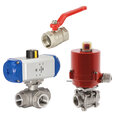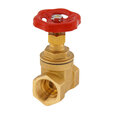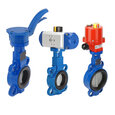Valve Lockout Devices
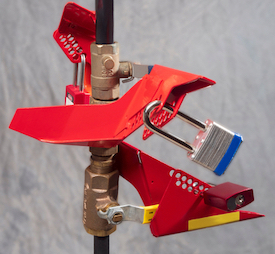
Figure 1: Ball valve lockout device
In industrial applications involving valves, it is essential to keep these valves operating safely and efficiently. A valve lockout system effectively ‘locks’ a valve, thereby preventing its accidental opening and preventing accidental fluid leakage and creating a hazardous environment. Choosing the correct lockout device for your valve is crucial for your home or business. This article gives a comprehensive review of lockout devices used in various valves.
Table of contents
- What is a valve lockout device?
- Color codes in valve lockout devices
- Choosing a valve lockout device
- Valve lockout device installation
- FAQs
View our online selection of valves!
What is a valve lockout device?
A network of pipes carries necessary fluids in an industry. An unexpected blockage or unregulated flow can cause a disaster. The pipes and equipment are vulnerable to potentially catastrophic damage or jeopardize the health and safety of employees. A valve lockout device is a locking system that physically prevents a valve operation. These devices help prevent potentially hazardous accidents during industrial repairs or maintenance works. A valve locking kit helps prevent unauthorized use of the valve. The lockout device is placed over the operational part of the valve. Most kits come with a handle that you can lock in place, making it impossible to turn the valve without the key.
Ball valve lockout device
A ball valve lockout device keeps a ball valve closed by securing the valve's handle in the OFF position, as seen in Figure 1. A lockable ball valve has lockout devices clamped over the valve lever preventing the lever from moving and turning the valve on. Hence the valve is prevented from opening accidentally and releasing dangerous chemicals or gases.
Butterfly valve lockout device
A butterfly valve lockout device is similar to a ball valve lockout device, but instead of clamping the device on the valve lever, a wedge on the slider fits between the compression handle and lever that prevents the compression handle from being squeezed to operate the valve.
Gate valve lockout device
Gate valve lockout device completely covers the valve, thereby preventing access to the valve. The device consists of two half-moons that are hinged on one side. The moons are placed over the valve, closed, and locked using padlocks.
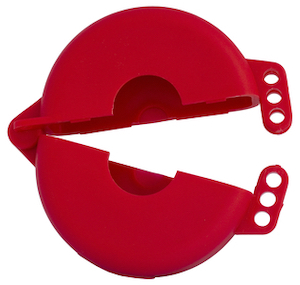
Figure 2: Gate valve lockout device
Color codes in valve lockout devices
Ball valve lockout devices are available in four ANSI color codes to identify the valve content, as listed in Table 1.
Table 1: ANSI color codes for valve lockout devices
| ANSI color code | Valve function |
| Yellow | Inherently hazardous materials |
| Red | Fire quenching materials |
| Blue | Minimally hazardous gases |
| Green | Minimally hazardous liquids |
Choosing a valve lockout device
While choosing valve lockout devices, consider the following factors while selecting:
- Valve size: Make sure to measure the circumference of the valve handle at its widest point before shopping for a lockout device.
- Valve handle shape: There are three common styles of handles found on ball valves: lever, T-shaped, and knob. Each requires a different style of lockout device, so it's essential to identify which type of handle you have before making a purchase.
- Valve material: You'll want to choose a lockout device made from a durable material that can withstand the elements if your valve is located outdoors.
- Brand: There are many brands of ball valve lockout devices on the market, so it's essential to do your research and select a brand that you can trust to provide a quality product.
- Price: Valve lockout devices can range in price, so it's essential to set a budget before shopping.
Valve lockout device installation
Ball valve locking kit installation
Perform the following steps to install a ball valve lockout device:
- Rotate the ball valve lever and keep the valve in the off position.
- Place the valve handle cover over the top of the ball valve handle.
- Slip the lockout sliding piece over the valve handle cover, and slide it on as far as possible.
- Secure the lockout device with a padlock. Slip the padlock shackle through one of the open holes at the top of the device and attach the lockout tag. The valve is now secured against unauthorized tampering.
Butterfly valve lockout device installation
Butterfly valve lockout devices come in various configurations:
- Slider type: The slider type lockout device is similar to a ball valve lockout device, except that the slider is placed between the compression handle and the lever to prevent the handle from being squeezed by accident.
-
Pressure plate type: Perform the following steps to install a screw-type butterfly lockout device.
- Place the butterfly valve handle in the fully closed or off position.
- Place the lockout device over the back of the lever handle so that the lever handle lies between the lockout device.
- Turn the knob of the lockout device clockwise to clamp the pressure plate securely to the handle.
- Place the padlock through the locking hole to secure the locked position.
Gate valve lockout device installation
Perform the following steps to install a gate valve lockout device:
- Place the two halves of the lockout device across the valve handle.
- Adjust the device tightly and secure it with a padlock.
- Slip the padlock shackle through one of the open holes at the top of the device and attach teh tag.
- The valve is now secured against unauthorized tampering.
Note: Valve lockout devices come in different configurations based on the manufacturer. Always refer to the manufacturer’s sheet for clear instructions on the installation process.
FAQs
What is a lockout valve?
Valve lockout devices are used to prevent the accidental opening of valves during system repair in industries.
What is a ball valve locking kit?
A ball valve locking kit helps prevent unauthorized use of a ball valve. Most kits come with a handle that can be locked in place, making it impossible to turn the valve without the key.





